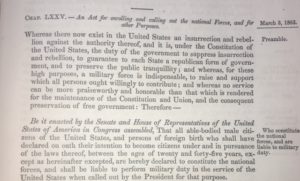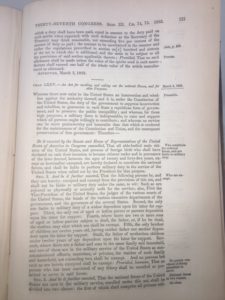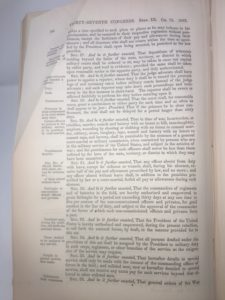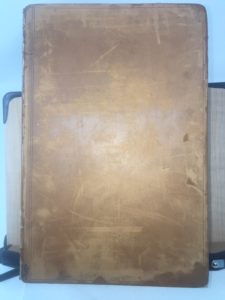CONSCRIPTION ACT OF 1863 – “An Act for enrolling and calling out the national Forces” during the Civil War:
[37th Congress, 2nd Session, Chapter 75, 12 Stat.731-737]
By 1863, it clear that an all volunteer army was insufficient to win Civil War. The Confederacy had created at draft in 1862. The federal government followed suit in March of 1863. The Act created a comprehensive system to draft all able-bodied white males between the ages of 20 and 45 for up to three years of military service and established a quota of troops due from each Congressional district.
The locally administered system relied on states to fill the enrollment quotas. Those who volunteered received a bounty of $100 from the federal government, along with state and local incentives. States preferred to fill their quotas with volunteers when possible. Because combined bounties could exceed $500, “bounty jumpers” would dessert and re-enlist to collect multiple bounties.
https://www.loc.gov/law/help/statutes-at-large/37th-congress/session-3/c37s3ch75.pdf
As described below by the preamble to the Act, the draft was considered “indispensable” to the “maintenance of the Constitution and Union” and the “preservation of free government.”
Whereas there now exist in the United States an insurrection and rebellion against the authority thereof, and it is, under the Constitution of the United States, the duty of the government to suppress insurrection and rebellion, to guarantee to each State a republican form of government, and to preserve the public tranquillity; and whereas, for these high purposes, a military force is indispensable, to raise and support which all persons ought willingly to contribute; and whereas no service can be more praiseworthy and honorable than that which is rendered for the maintenance of the Constitution and Union, and the consequent preservation of free government.
In addition to white males between the ages of 20 and 45, the draft also applied to resident aliens who had applied for citizenship. While the Act created a mandatory draft, controversial exemptions existed for those who were able to provide an acceptable “substitute” (§17) or could afford to pay a $300 “commutation” fee (§13).
The $300 commutation fee was arguably the most controversial part of the bill and gave rise to the criticism that the war was a “rich man’s war and a poor man’s fight.” The practice of paying for substitutes had a long tradition in Europe and had also been employed during the American Revolution. In 1864, Congress repealed the commutation fee.
The strongest opposition to the draft came from the urban poor. Many considered the draft process to be poorly organized and unfair, particularly since federal enrolling officers created the conscription lists. The procedure could be perceived as discriminatory when personal favoritism, including ethnic prejudice was shown. Analysis of the conscription lists by historians not surprisingly demonstrates that immigrants and the poor were disproportionately drafted.
On July 11, 1893, the first names were called for conscription. The following day, riots broke out in New York City. The Democratic candidate for governor, Horatio Seymour, asserted that the draft was unconstitutional and claimed that more Democrats were drafted that Republicans. The draft office of the provost marshal was burned, railroad lines were sabotaged, and telegraph lines were cut. The rich (referred to as “$300 men”) and African Americans were targeted during mob violence. Five army regimens, local police and cadets from West Point were required to quell the rioting, which resulting in over 100 deaths
Lincoln’s humility and ability stay in touch with average Americans helped him humanize the war effort and minimize opposition. Through letters to newspapers and correspondence with the families of fallen soldiers, Lincoln purposely and effectively demonstrated that he cared for the suffering.






